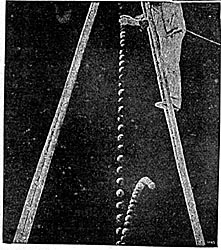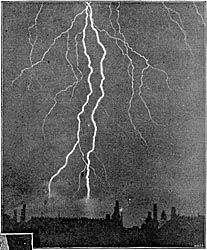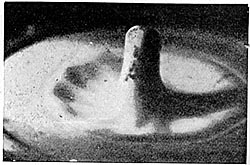Some Curiosities of Modern Photography. Part I.
By William G. FitzGerald
Previous Section
Here is another curious photo. placed at my disposal by Mr. Wall. A man has mounted a step ladder and let fall an indict-rubber ball, which has been photographed at intervals during its passage to the ground, and even after its rebound (Fig. 18).

Fig. 18.—Motion of an India-rubber ball. | 
Fig. 19.—A flash of lightning. |
I will merely mention such photographic curiosities as Francis Galton's composite system, whereby members of a class of society are photographed singly and then blended to obtain a typical character; a man being hanged (he is falling through the pit, his face is enveloped in a white cloth, and one of his slippers has preceded him by a few feet; this was taken in Germany); and lightning flashes, simplest of all instantaneous photographs: just place your camera in the window, wait for the flash, and then develop your plate (Fig. 19). The double flash I reproduce, by the way, set fire to a huge factory; and after he had photographed the cause, Mr. A. R. Dresser went forth next morning and secured a picture of the result.
I have also seen Professor Marey's photo-chronographs of flying insects, obtained by an exposure lasting the l-25,000th part of a second; and photographs of Mont Blanc, taken by M. Boissonais with a tele-photographic Dallmeyer lens at a distance of fifty-six miles, the exposure lasting seven minutes (Fig. 20). Captain Abney, the Royal Photographic Society's learned vice-president, has succeeded in taking weird moonlight photographs of Chamounix from his hotel window.

Fig. 21.—Stream of water breaking into drops. | 
Fig. 22.—The drop falling. |

Fig. 23.—The drop striking the milk. |
I will include in my list the beautiful pictures of falling water taken by Lord Rayleigh, with an electric spark (Fig. 21). I wish to gratefully acknowledge here the courtesy extended to me by that eminent and popular scientist. I have also been able to reproduce Professor Worthington's wonderful photographs of a drop of water falling into a vessel of milk. The professor adopted Lord Rayleigh's method, the duration of the Leyden jar spark being the 1-100,000th of a second. The drop of water is first shown falling (Fig. 22), then it is seen striking, the surface of the milk (Fig. 23) and throwing up little drops from a sort of crater (Fig. 24), and lastly, a column of liquid raises itself (Fig. 25), after which the drop subsides.

Fig. 24.—The drop producing a crater of milk. | 
Fig. 25.—The drop raising a column of milk. |
(To be continued.)






